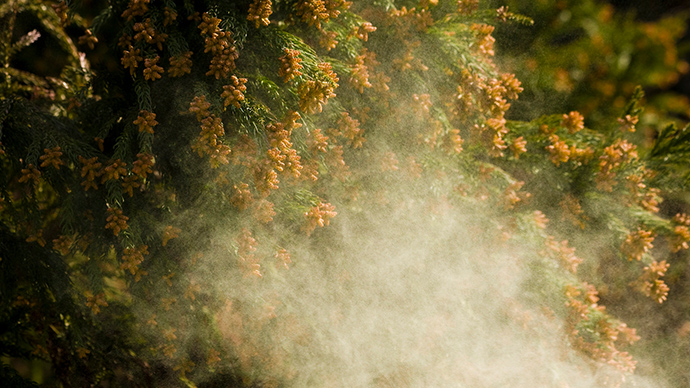Simultaneous decomposition of pollen + exhaust gas + PM2.5 which worsens hay fever
It was found that the streamer technology decomposes cedar pollen, and at the same time, it also decomposes exhaust gas (diesel exhaust particles) and PM2.5 that worsen hay fever, dramatically reducing the intensity of allergic reactions.

Department of Rehabilitation,
Faculty of Medical Science and Welfare,
Tohoku Bunka Gakuen University
- This is the demonstration result using a streamer discharge device for testing.
- The effect of products equipped with Streamer technology or the effect in actual use environment may differ.
Pollen + exhaust gas + PM2.5 are decomposed at the same time, reducing the allergenic strength by 92.4%

As a result of the test, the allergenic strength was 2.36 times higher in the D group, in which exhaust gas and PM2.5 were added to the allergen, than in the A group containing only the allergen. It is speculated that the simultaneous administration of a mixture of exhaust gas and PM2.5 enhanced the immune reaction that causes allergic symptoms such as hay fever. On the other hand, the allergenic strength of group E, which was exposed to the Streamer for 48 hours, was reduced by 92.4% compared to group D.
- This is the demonstration result using a streamer discharge device for testing.
- The effect of products equipped with Streamer technology or the effect in actual use environment may differ.
Testing organization
Demonstrated at Yamagata University under the supervision of Professor Shirasawa, Tohoku Bunka Gakuen University
Test method
A comparative experiment was performed on 3 groups of mice. (Group A) allergen, (B group) allergen + exhaust gas, (C group) allergen + PM2.5, (D group) allergen + exhaust gas + PM2.5, (Group E) allergen + exhaust gas + PM2.5 after the Streamer irradiation, was administered respectively. Administration to mice was continued every 2 weeks, and 8 weeks later, IgE antibody*1 concentration in the blood of the mice was measured. We used ovalbumin as the allergen, which is a typical substance used in immunity experiments as an alternative to pollen.
When a reaction with an allergen occurs in the body, an IgE antibody that can bind only to the allergen is produced, and when the reentered allergen reacts with the IgE antibody, various allergic symptoms are caused. Since it is detected only in a very small amount in healthy people, it is generally used for immunological tests.
Hay fever development
Adjuvant substances that worsen allergic symptoms may adhere to pollen, which may upset the balance that was previously maintained and increase the risk of developing hay fever.
The Image of the hay fever development


Source: https://www.daikin-streamer.com/en/kafun/

